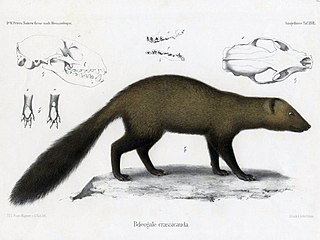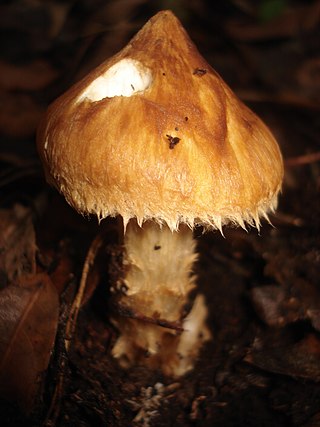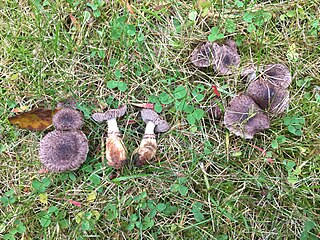
The International Union for Conservation of Nature (IUCN) Red List of Threatened Species, also known as the IUCN Red List or Red Data Book, founded in 1964, is an inventory of the global conservation status and extinction risk of biological species. A series of Regional Red Lists, which assess the risk of extinction to species within a political management unit, are also produced by countries and organizations.

Agaricus bisporus, commonly known as the cultivated mushroom, is a basidiomycete mushroom native to grasslands in Eurasia and North America. It is cultivated in more than 70 countries and is one of the most commonly and widely consumed mushrooms in the world. It has two color states while immature – white and brown – both of which have various names, with additional names for the mature state, such as chestnut, portobello, portabellini, button and champignon de Paris.

Gyps is a genus of Old World vultures that was proposed by Marie Jules César Savigny in 1809. Its members are sometimes known as griffon vultures. Gyps vultures have a slim head, a long slender neck with downy feathers, and a ruff around the neck formed by long buoyant feathers. The crown of their big beaks is a little compressed, and their big dark nostrils are set transverse to the beak. They have six or seven wing feathers, of which the first is the shortest and the fourth the longest.

A threatened species is any species which is vulnerable to extinction in the near future. Species that are threatened are sometimes characterised by the population dynamics measure of critical depensation, a mathematical measure of biomass related to population growth rate. This quantitative metric is one method of evaluating the degree of endangerment without direct reference to human activity.

The conservation status of a group of organisms indicates whether the group still exists and how likely the group is to become extinct in the near future. Many factors are taken into account when assessing conservation status: not simply the number of individuals remaining, but the overall increase or decrease in the population over time, breeding success rates, and known threats. Various systems of conservation status are in use at international, multi-country, national and local levels, as well as for consumer use such as sustainable seafood advisory lists and certification. The two international systems are by the International Union for Conservation of Nature (IUCN) and The Convention on International Trade in Endangered Species of Wild Fauna and Flora (CITES).

A genet is a member of the genus Genetta, which consists of 17 species of small African carnivorans. The common genet is the only genet present in Europe and occurs in the Iberian Peninsula, Italy and France.

Bdeogale is a mongoose genus that was proposed by Wilhelm Peters in 1850 based on a mongoose specimen collected in Mozambique. Bdeogale species have compact paws with four symmetrical toes, round ears and a blunt muzzle with a broad round and bare rhinarium. The genus contains four species that are primarily terrestrial and omnivorous and forage in dense vegetation.

A least-concern species is a species that has been categorized by the International Union for Conservation of Nature (IUCN) as evaluated as not being a focus of wildlife conservation because the specific species is still plentiful in the wild. They do not qualify as threatened, near threatened, or conservation dependent.

Lemniscomys, sometimes known as striped grass mice or zebra mice, is a genus of murine rodents from Africa. Most species are from Sub-Saharan Africa; L. barbarus is the only one found north of the Sahara. They are generally found in grassy habitats, but where several species overlap in distribution there is a level of habitat differentiation between them.
Eisentraut's striped mouse or Eisentraut's hybomys is a species of rodent in the family Muridae. It is found only in Cameroon. Its natural habitat is subtropical or tropical moist montane forests. It is threatened by habitat loss.
The Cameroon soft-furred mouse or Cameroon praomys is a species of rodent in the family Muridae. It is found in Cameroon and Equatorial Guinea. Its natural habitat is subtropical or tropical moist montane forests. It is threatened by habitat loss.
Verschuren's swamp rat is a species of rodent in the family Muridae. It is found only in Democratic Republic of the Congo. Its natural habitat is subtropical or tropical moist lowland forests. It is threatened by habitat loss.

The canary flyrobin, also known as the Papuan flycatcher, canary robin, canary flycatcher, or montane flycatcher, is a species of bird in the family Petroicidae. It is found in New Guinea. Its natural habitat is subtropical or tropical moist montane forests with elevations from 1,100–3,500 m (3,609–11,483 ft). Currently, its population is believed to be stable.

The Viverrinae represent the largest subfamily of the Viverridae comprising three genera, which are subdivided into six species native to Africa and Southeast Asia. This subfamily was denominated and first described by John Edward Gray in 1864.

Paradoxurinae is a subfamily of the feliform viverrids that was denominated and first described by John Edward Gray in 1864. Pocock subordinated the genera Paradoxurus, Paguma and Arctictis to this subfamily.

Squamanita is a genus of parasitic fungi in the family Squamanitaceae. Basidiocarps superficially resemble normal agarics but emerge from parasitized fruit bodies of deformed host agarics.

Fallow deer is the common name for species of deer in the genus Dama of subfamily Cervinae.

Genettinae is a subfamily of the feliform viverrids. It contains all of the genet species and the oyan species.

Dissoderma odoratum is a species of fungi in the family Squamanitaceae. It is a distinctly strong-smelling species with small, purple sporocarps. The fungus parasites in the sporocarps of the veiled hebeloma, which are deformed by the parasitic fungus. Dissoderma odoratum is mostly found in Europe but has also been found from the United States. The fungus is a rare species that is classified as endangered in several European countries.














